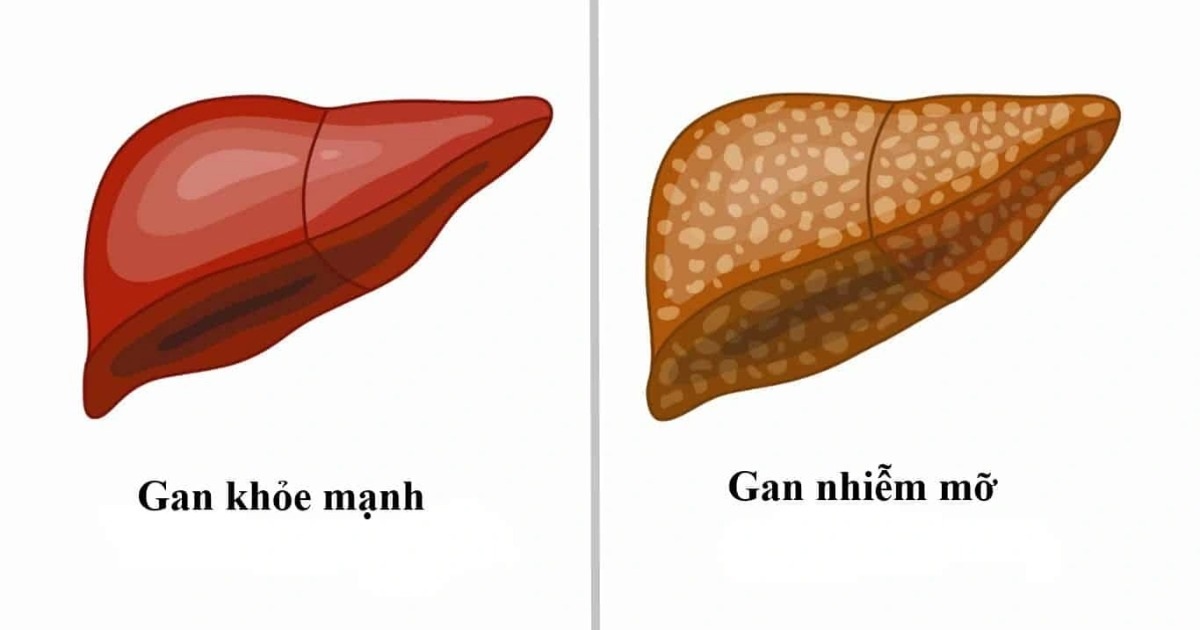Fatty liver disease is a serious underlying condition that can lead to liver cancer even in stages F1 and F2 without necessarily progressing to cirrhosis.
Furthermore, fatty liver disease increases the risk of colon cancer twenty-fold and affects other non-liver conditions like cardiovascular disease, chronic kidney disease, and sleep apnea.
Fatty liver disease occurs when excessive fat accumulates in the liver (over 5% of the liver’s weight), impacting liver function.
Image of fatty liver and healthy liver (Image: Getty).
The disease is commonly found in individuals consuming high-sugar, high-fat foods, and alcohol; those who are overweight, obese, and lead sedentary lifestyles. However, it can also affect thin individuals due to metabolic disorders or genetic factors.
Significantly, fatty liver disease often shows no clear symptoms in its early stages. Only when the disease progresses can symptoms appear, such as:
- Fatigue and discomfort.
- Skin itching, hives, and allergies: Hives or itching can be a sign of fatty liver.
- Pain or a feeling of heaviness in the upper abdomen.
- Loss of appetite, nausea, unexplained weight loss, especially for high-fat foods.
- In severe cases, the disease can lead to cirrhosis or hepatitis, causing serious liver dysfunction, including jaundice, nosebleeds, and bleeding gums. Critically, it can develop into liver cancer.
According to Dr. Lưu Thị Minh Diệp, to assess fatty liver disease, patients undergo blood tests, liver ultrasounds, and even CT scans to accurately determine the liver condition, especially in progressive cases.
In severe cases of fatty liver disease where doctors suspect complications like hepatitis or cirrhosis, a liver biopsy may be performed to precisely determine the extent of liver damage.
For patients diagnosed with fatty liver disease, monitoring disease progression with liver elastography is crucial. This non-invasive method assesses liver stiffness and fat content.
Fat accumulation stages correspond to the percentage of fatty liver cells: S0 corresponds to 0-10% (normal), S1 (mild fatty liver) has 11-33%, S2 (moderate fatty liver) has 34-66%, and S3 (severe fatty liver) has 67-100%.
Dr. Diệp asserts that fatty liver disease is a preventable and treatable condition if detected early.
To prevent fatty liver disease, individuals should adopt a healthy diet, consuming plenty of fruits, vegetables, fiber-rich foods, and limiting sugar, fat, and processed foods.
Eating plenty of fruits, vegetables, and increasing physical activity help prevent fatty liver (Image: Tú Anh).
In addition, regular exercise for at least 30 minutes daily is necessary. Activities like walking, jogging, swimming, or yoga can help manage weight and reduce body fat.
For obese individuals, weight loss can significantly reduce the risk of fatty liver disease. Every degree of weight loss improves liver conditions. Specifically, losing more than 3% improves fat content, more than 5-7% improves hepatitis, and over 10% improves fibrosis.
Controlling underlying conditions like diabetes and high blood pressure and having regular health checkups are also essential.



